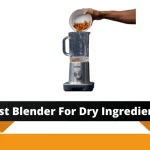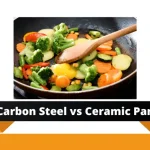Silicone cookware has gained significant popularity in the culinary world, presenting advantages and disadvantages for avid home cooks and professional chefs. Understanding the Pros and Cons of Silicon Cookware is essential to making informed kitchen decisions.
On the one hand, silicone cookware boasts nonstick properties, high heat resistance, and remarkable versatility, making it an attractive choice for various cooking and baking tasks. However, it is equally important to consider potential limitations, such as limited browning and searing capabilities, the need for greasing, and concerns regarding silicone leaching into food.
By exploring the pros and cons of silicone cookware, we can uncover its benefits while being mindful of its limitations, enabling us to optimize our cooking experiences and achieve delectable results.
What is Silicone Cookware?
Table of Contents,
Silicone cookware is made from a synthetic polymer derived from silicon, oxygen, carbon, and hydrogen. It is known for its flexibility, heat resistance, and non-stick properties, making it a popular choice for baking molds, spatulas, and other kitchen utensils.
Pros and Cons of Silicone Cookware
When considering silicone cookware for your culinary needs, it is crucial to understand the pros and cons of silicone cookware. By examining its advantages and disadvantages, you can make an informed decision about incorporating silicone cookware into your kitchen arsenal.
| Pros of Silicone Cookware | Cons of Silicone Cookware |
|---|---|
| Nonstick surface | Limited heat resistance |
| Versatility | Less browning or crisping |
| Lightweight and easy to handle | Not suitable for stovetop use |
| Easy to clean | Potential odor absorption |
| Non-reactive | Can be prone to staining |
| Heat insulation | Requires extra care |
Pros of Silicone Cookware:
Non-stick Properties:
One of the primary advantages of silicone cookware is its excellent non-stick surface. This property eliminates the need for excessive oil or cooking sprays, making it a healthier option for cooking and baking.
Heat Resistance:
Silicone cookware can withstand high temperatures, typically up to 450°F (232°C) or even higher. This heat resistance makes it suitable for various cooking methods, including baking, roasting, and microwaving.
Versatility:
Silicone cookware is available in various shapes and sizes, making it versatile for culinary needs. From baking moulds to spatulas and oven mitts, there is a silicone kitchen tool for almost every cooking task.
Lightweight and Flexible:
Silicone cookware is lightweight and flexible, making it easy to handle and store. Its flexibility allows for easy removal of baked goods from molds and easy folding or rolling for compact storage.
Cons of Silicone Cookware:
Limited Browning and Crisping:
Silicone cookware does not promote browning and crisping as effectively as materials like metal or glass. While it is excellent for non-stick purposes, achieving a golden-brown crust or crispy texture may be challenging with silicone pans or baking sheets.
Potential Leaching:
There have been concerns about the potential leaching of compounds from silicone cookware into food, especially when exposed to high temperatures or acidic ingredients. However, current research suggests that the leaching is minimal and within acceptable limits for human consumption.
Not Suitable for High-Heat Direct Flame:
While silicone cookware is heat resistant, it is unsuitable for direct exposure to high heat, such as an open flame. Extreme temperature fluctuations can damage silicone, so caution should be exercised when using it near intense heat sources.
Prone to Scratching:
Silicone cookware is generally durable, but it is not entirely scratch-resistant. Sharp utensils or abrasive cleaning tools can leave marks or scratches on the surface, potentially compromising its non-stick properties and creating crevices where bacteria can grow.
Silicone cookware offers several advantages, including non-stick properties, heat resistance, and versatility. However, it is important to consider its limitations, including limited browning capabilities, potential leaching, sensitivity to high heat, and susceptibility to scratching. By weighing the pros and cons, you can determine if silicone cookware is the right choice for your culinary needs and preferences.
Safety of Silicone Cookware:
Silicone cookware is generally considered safe for use in cooking and food preparation. It is inert and does not react with food or produce harmful fumes when heated. Unlike traditional cookware materials like Teflon, silicone does not contain PFOA or PTFE, potentially hazardous chemicals.
Potential Health Risks:

While silicone cookware is generally safe, there are some concerns worth considering. One potential risk is leaching certain compounds from the silicone into food when exposed to high temperatures or acidic ingredients. However, studies have shown that this leaching is minimal and within acceptable limits for human consumption.
To minimize any potential risks, it is important to follow proper usage and care guidelines for silicone cookware. Avoid using sharp utensils that may scratch the surface, as this can create crevices where bacteria can grow. Additionally, handwashing with mild detergent is recommended, as dishwashers may degrade the silicone over time.
How do you know the cookware is 100% silicone? Identifying Genuine Silicone
“100% food grade silicone” refers to silicone specifically formulated and manufactured to meet the safety standards for direct contact with food. It indicates that the silicone material does not contain harmful chemicals or additives that could leach into food during cooking or baking.
100% silicon undergoes rigorous testing to ensure compliance with food safety regulations. It is free from substances like BPA (Bisphenol A), phthalates, lead, and other toxic materials that could pose health risks.
Tips for Determining if Silicone is Truly 100% Silicone:
Look for reputable manufacturers known for producing high-quality silicone products. Check if they provide transparent information about their materials and production processes. Trusted manufacturers often have third-party certifications or compliance with food safety standards.
Read Product Labels and Descriptions:
Carefully read the labels and product descriptions. Look for explicit statements indicating that the silicone used is “100% food grade” or “food-safe.” Bakerpan Silicone Round Collapsible Space Saving Pot and Silicone Muffin Pan are made of 100% food-grade silicone with BPA-free, LFGB Approved.

Be cautious of vague or generic terms like “silicone-like” or “food-friendly” that may not guarantee food-grade quality.
Check for Certifications:
Look for certifications from recognized regulatory bodies, such as the FDA (Food and Drug Administration), or Research the Manufacturer:
LFGB (Lebensmittel- und Futtermittelgesetzbuch) ensures the silicone meets strict food safety standards.
Odor and Appearance:
High-quality food-grade silicone should not have a strong chemical or plastic-like odor. It should have a neutral scent. Additionally, visually inspect the silicone for any discoloration or signs of degradation, which may indicate a lower-quality material.
Non-Stick Performance:
Food-grade silicone generally exhibits excellent non-stick properties. If your silicone cookware consistently provides good non-stick performance, it can indicate its food-grade quality. However, remember that non-stick performance alone is not a definitive indicator.
Comparison Analysis of Silicon Cookware
These comparison tables highlight the key features and characteristics of silicone cookware compared to Teflon-coated, stainless steel, and cast iron cookware. Each type of cookware has advantages and considerations, and the best choice depends on individual preferences and needs.
Silicone Cookware vs Teflon-coated Cookware
| Features | Silicone Cookware | Teflon-coated Cookware |
| Non-stick | Yes | Yes |
| Heat Resistance | High | Moderate |
| Versatility | Highly versatile for various cooking methods | Limited to stovetop and oven use |
| Durability | Prone to scratching and wear over time | Non-stick coating can wear off and may require replacement |
| Browning/Crisping | Limited browning and crisping capabilities | Good for browning and crisping |
| Health Concerns | Generally considered safe for cooking | Potential release of harmful fumes when overheated |
| Maintenance | Easy to clean and dishwasher safe | Requires gentle cleaning to avoid scratching |
Silicone Cookware vs. Stainless Steel Cookware
| Features | Silicone Cookware | Stainless Steel Cookware |
| Non-stick | Yes | No (unless coated) |
| Heat Conductivity | Moderate | Good |
| Versatility | Highly versatile for various cooking methods | Versatile for different cooking techniques and oven use |
| Durability | Prone to scratching and wear over time | Durable and long-lasting |
| Browning/Crisping | Limited browning and crisping capabilities | Excellent for browning and crisping |
| Health Concerns | Generally considered safe for cooking | Generally considered safe for cooking |
| Maintenance | Easy to clean and dishwasher safe | Easy to clean and may require occasional polishing |
Silicone Cookware vs. Cast Iron Cookware
| Features | Silicone Cookware | Cast Iron Cookware |
| Non-stick | Yes | Yes (when properly seasoned) |
| Heat Conductivity | Moderate | Excellent |
| Versatility | Highly versatile for various cooking methods | Versatile for stovetop, oven, and outdoor cooking |
| Durability | Prone to scratching and wear over time | Extremely durable and long-lasting |
| Browning/Crisping | Limited browning and crisping capabilities | Excellent for browning and crisping |
| Health Concerns | Generally considered safe for cooking | Generally considered safe for cooking |
| Maintenance | Easy to clean and dishwasher safe | Requires seasoning and proper maintenance |
ALSO, READ.
- What Type Of Oil Is Best For An Air Fryer?
- Why do Pans and Baking Sheets Warp in the Oven?
- Carbon Steel vs. Ceramic Pan
FAQs.
Silicone has not become a widespread substitute for plastic for several reasons. Firstly, silicone tends to be more expensive than traditional plastics, making it less affordable for large-scale manufacturing and widespread use. Additionally, silicone has certain limitations regarding its versatility and application range, which restricts its suitability for various industries and products. Moreover, the existing infrastructure and familiarity with plastic make it more challenging for silicone to gain widespread acceptance. Plastic has been widely used for many years, and manufacturers, consumers, and recycling facilities are well-adapted to its properties and recycling processes. These factors contribute to the limited adoption of silicone as a plastic alternative.
Food-grade silicone and ordinary silicone typically have similar durability. The difference between the two lies in their intended use rather than their inherent durability. Food-grade silicone is specifically formulated and certified to meet food safety standards, ensuring it is safe for contact with food. It undergoes rigorous testing and certification processes to ensure its suitability for culinary applications.
Food-grade silicone is designed to be safe for food contact, and it does not necessarily imply that it is more durable than ordinary silicone. The durability of silicone products depends on factors such as the quality of the material, manufacturing processes, and specific product design. Both food-grade silicone and ordinary silicone can exhibit similar levels of durability when made with high-quality materials and proper manufacturing techniques.
Yes, silicone is safe for boiling water. Silicone is a heat-resistant material that can withstand high temperatures without melting or releasing harmful substances. It is commonly used in kitchen utensils, cookware, and baking mats that directly interact with boiling water or hot liquids. However, ensuring that the silicone used is specifically designed for high-temperature applications and labeled as heat-resistant or food-grade is essential. Using low-quality or non-food-grade silicone products may pose safety risks.
No, silicone does not leach microplastics. Microplastics are tiny particles of plastic found in the environment due to the breakdown of more oversized plastic items or synthetic fibers. Conversely, silicone is a stable polymer made from silicon, oxygen, carbon, and hydrogen. It does not break down or degrade like traditional plastics and therefore does not release microplastics. However, choosing high-quality, food-grade silicone products is essential to ensure they do not contain any additives or impurities that could leach into food or liquids. Proper usage and maintenance of silicone items can help minimize potential risks and ensure their safety.
Silicone does not have the potential to disrupt hormones. Silicone is an inert and non-reactive material, meaning it does not contain substances that mimic or interfere with hormonal activity in the body. It is widely regarded as a safe material for various applications, including medical implants, baby products, and kitchenware. However, it is essential to note that certain additives or impurities found in low-quality silicone products could pose potential health risks. Choosing high-quality, food-grade silicone items from reputable manufacturers is recommended to ensure safety.
Conclusion
In conclusion, the use of silicone cookware presents a multitude of advantages that make it a popular choice among home cooks. Silicone cookware’s remarkable non-stick properties and heat resistance ensure effortless cooking and cleaning experiences. At the same time, it’s essential to be mindful of potential health risks and ensure the use of high-quality, 100% silicone cookware. The benefits of this versatile material make it a valuable addition to any kitchen. So, if you’re seeking a practical and efficient cooking companion, silicone cookware emerges as the best option.






